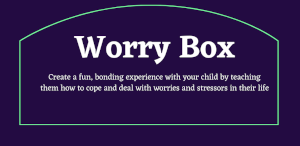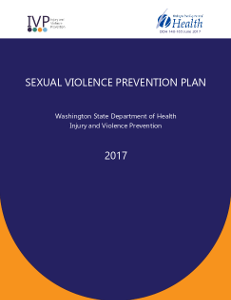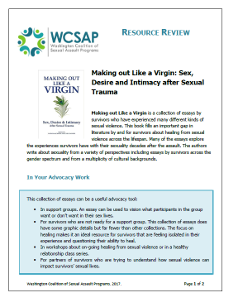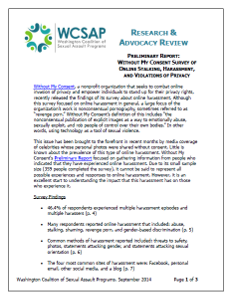- Prevention
- Working With Survivors
- Accreditation
- Advocacy Areas
- Culturally Specific
- Legal Resources
- Management
- Medical Resources
- SA Protection Order
- Subpoenas
- Support Groups
- Tech Safety
- Resources
- Policy
- Training
Strategies
- Preset filters:
- Topic: Strategies
- All filters are available on the Resources page.
Folleto para los cuidadores
-> TYPE MISSING, FIX ME <-
April, 2022
Topic
- Advocacy
- Child Sexual Abuse
- Latinx
- Consent
- Schools & Campus
Brochure
-> TYPE MISSING, FIX ME <-
April, 2022
Topic
- Schools & Campus
Postcard
WCSAP Webpage
April, 2022
_Page_1.png)
_Page_2.png)
Topic
- Parents & Caregivers
- Healthy Sexuality
- Schools & Campus
Tarjeta Postal
WCSAP Webpage
April, 2022
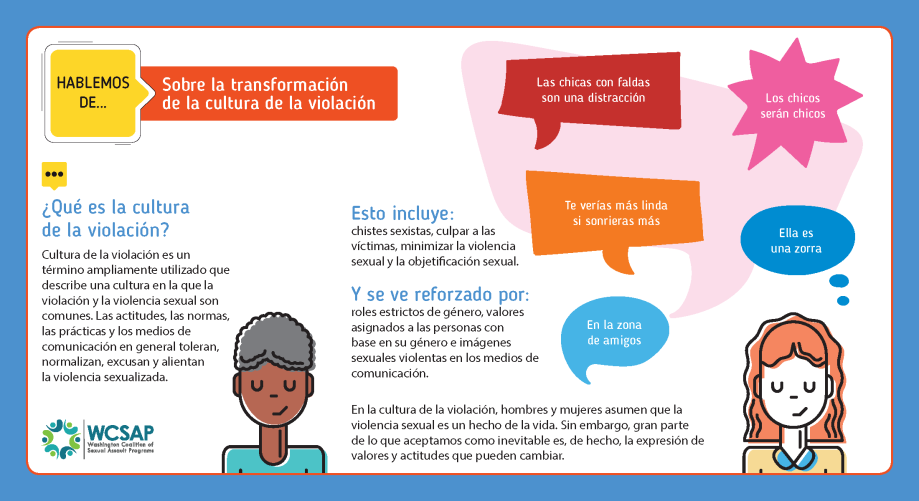
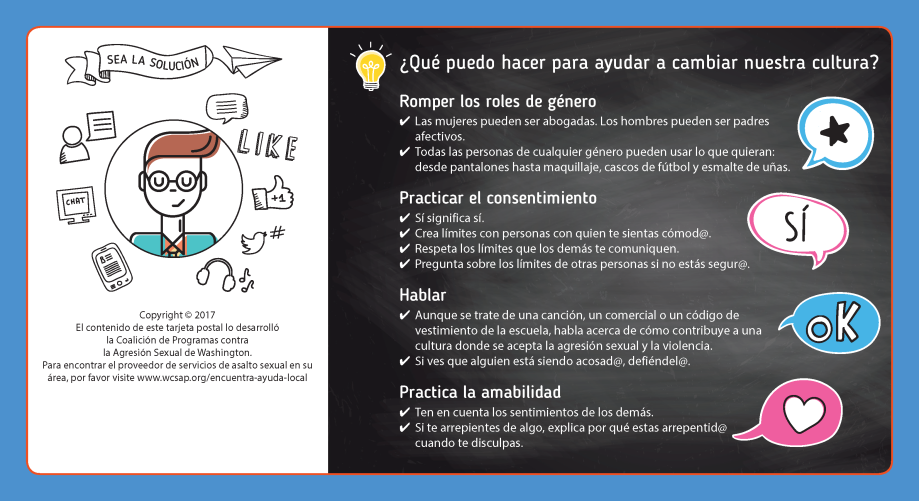
Topic
- Parents & Caregivers
- Culturally Specific
- Latinx
- Healthy Sexuality
- Schools & Campus
Fundamentación y Manejo de Ansiedad en Niños Jóvenes, Serie: Parte 2 de 3
WCSAP Webpage
December, 2021
Bienvenidos a la segunda parte de nuestra trilogía sobre la Fundamentación y Manejo de Ansiedad en Niños Jóvenes. Nuestro enfoque en esta serie es de modelar actividades que son divertidas, simples, y educativas que usted pueda enseñar a toda su familia - especialmente a sus chiquitines - para poder manejar el estrés y la ansiedad. En esta segunda parte estaremos aprendiendo como hacer una “Caja de Preocupaciones”.
Caja de Preocupaciones
Crea una experiencia divertida y…
Topic
- Child Sexual Abuse
- Parents & Caregivers
- Healthy Relationships
Sex Positivity as Sexual Violence Prevention
Webinar
May, 2021
This workshop brings a sex-positive lens to prevention, shifting the goal from consensual transactions to pleasurable play. We will explore mainstream sexual norms — from “foreplay” to fake orgasms — and how they perpetuate a sex-negative, rape culture. In an effort to envision beyond more than simply consent, we will also discuss sexual liberation, lessons learned from BDSM, and what happens when we make good sex our ultimate goal.
Topic
- Prevention
- Consent
- Healthy Sexuality
Engaging LGBTQ+ communities in creative primary violence prevention projects
Webinar
May, 2021
Utilizing creative and concrete tools in this fun and interactive workshop by Queery, participants can enhance their school-based and organizational primary violence prevention projects. Although Queery's art-based education programs are designed by and for the LGBTQ+ BIPOC communities, the underlying concepts can be used across a variety of violence prevention platforms.
Queery's name comes from the combination of the sociological critical lens called "Queer Theory. " Queer theories…
Topic
- LGBTQ
- Prevention
- Culturally Specific
Grounding and Anxiety Management with Young Children Series: Part 2 of 3
PDF
April, 2021
Welcome to the second installment in our 3-part series on grounding and anxiety management with young children! In this series we are focusing on simple, fun, and helpful activities that you can teach anyone in your family, including young children, to help them cope with stressors and anxiety. For our second activity, we will be learning how to make a "Worry Box".
Worry Box
Create a fun, bonding experience with your child by teaching them how to cope and deal with worries and…
Topic
- Child Sexual Abuse
- Parents & Caregivers
- Training Tools
- Guides & Activities
- Awareness Raising
Webinar
June, 2020
This workshop will explore tips and tricks for more digitally focused prevention. This may be especially helpful as prevention plans are adjusted in response to current social distancing but will also provide valuable approaches to keep in your toolbox going forward.
Presenters will share and discuss several tools to use while engaging in prevention efforts virtually, including digital art practices and engaging and accessible online facilitation. Participants will also have…
Topic
- Media Literacy & Technology
Advocate Core Part 1
Webinar
April, 2020
This webinar is broken into two parts.
- Part One
- This presentation will discuss different examples of how rape culture is ingrained in our culture, history and systems. We will also review different aspects of how rape culture is exhibited throughout our daily lives.
- Part Two
- We will also look at how oppression and rape culture connect and why it is important for sexual assault advocates to have foundational knowledge in anti-oppression. We will…
Topic
- Root Causes
Advocate Core Part 2
Webinar
April, 2020
This webinar is broken into two parts.
- Part One
- This presentation will discuss different examples of how rape culture is ingrained in our culture, history and systems. We will also review different aspects of how rape culture is exhibited throughout our daily lives.
- Part Two
- We will also look at how oppression and rape culture connect and why it is important for sexual assault advocates to have…
Topic
- Root Causes
Including Youth With Intellectual Disabilities in Prevention Groups
Webinar
December, 2018
Many sexual assault service professionals feel unprepared when youth with intellectual disabilities (ID) participate in prevention groups. However, we should expect to see more youth with ID in such groups because of the current focus on inclusion in the public-school system.
This webinar will provide information and resources to assist the S/A professional to feel more confident in meaningfully including and supporting a prevention group participant with ID.
Topic
- Prevention
- Disability
WCSAP Webpage
November, 2018
In our industry as Managers, Supervisors and Executive Directors there are a plethora of gifting's that are bestowed to us in how we serve, advocate and add value to our organizations and or coalitions. In order to serve with due diligence we have to be willing to strive towards working as experts on a mission to eliminate any and all forms of oppression that serves to corrode and undermine the work of the anti-sexual violence movement.
The main form of oppression tends to rear its…
Topic
- Anti-Oppression
- Management
- Culturally Specific
To Inform Primary Prevention Programming
Webinar
May, 2018
This webinar will provide an overview of definitions of and recent research regarding factors that elevate risk for sexual assault perpetration. Contributors to sexual violence at the individual, social network, and broader societal level will be considered, as will both general risk factors and culturally and community-specific factors. Participants will be engaged in identifying risk and protective factors in the communities they serve and identifying ways to prioritize and target specific…
Topic
- Strategies
WCSAP Webpage
March, 2018
Many sexual violence prevention efforts aim to change individual beliefs and attitudes that contribute to a culture where sexual violence is prevalent. While these strategies are an important piece of the puzzle when it comes to creating social change, a more comprehensive approach that addresses environmental and social factors that lead to these beliefs and attitudes is necessary in preventing sexual violence. Engaging in effective community level prevention is crucial in our efforts to…
Topic
- Strategies
PDF
June, 2017
2017 Sexual Violence Prevention Plan
We are pleased to present the "2017 Sexual Violence Prevention Plan," an update to the "2009 Sexual Violence Prevention Plan, Synergies." The period surrounding the development of the 2009 plan was the culmination of a shift in statewide focus away from risk reduction efforts, and toward perpetration reduction. The 2017 plan builds upon that transition. It emphasizes community-driven decision-making and encourages efforts to track and evaluate…
Topic
- Planning
- Strategies
Sex, Desire and Intimacy After Sexual Trauma
PDF
February, 2017
"Making Out Like a Virgin: Sex, Desire, and Intimacy After Sexual Trauma" is a collection of essays by survivors who have experienced many different kinds of sexual violence. This book fills an important gap in literature by and for survivors about healing from sexual violence across the lifespan.
Many of the essays explore the experiences survivors have with their sexuality decades after the assault. The authors write about sexuality from a variety of perspectives including essays…
Topic
- Healthy Sexuality
WCSAP Webpage
November, 2015
For many of us music can have an important and influential role in our lives. It's more than just a means of enjoyment though, it can also be a platform for communicating social norms. That's why a lot of prevention efforts include media literacy skills. As preventionists, one of our biggest roles is to facilitate meaningful conversations that will help lead communities towards prevention that is personal and more likely to be effective. Therefore before diving right into the fun of…
Topic
- Media Literacy & Technology
WCSAP Webpage
June, 2015
This tip is about consent-now I know you might be thinking, again? But hear me out.
Yes, consent is a fairly common topic area in sexual assault prevention, and there are good reasons for that. Far too often though we come up with reasons why we CANNOT teach consent. Things like the kids I'm working with are too young for that, or the school doesn't let us talk about sex. And this is why this Tip is about consent... without sex.
It's About So Much More
A recent…
Topic
- Consent
WCSAP Webpage
September, 2014
In our work to end sexual violence, sometimes best practices in prevention and what communities want to hear about (i.e. awareness and education) are not the same thing. Large school assemblies and tips for staying safe at parties are often welcomed by our communities — these make them feel safe and don't ask too much of them. With limited resources to do our prevention work, it is important that we are able to distinguish between primary prevention and awareness or risk reduction activities…
Topic
- Best Practices
- Awareness Raising
- Theory & Concepts
Without My Consent Survey of Online Stalking, Harassment, and Violations of Privacy
PDF
September, 2014
Without My Consent, a nonprofit organization that seeks to combat online invasion of privacy and empower individuals to stand up for their privacy rights, recently released the findings of its survey about online harassment. Although this survey focused on online harassment in general, a large focus of the organization's work is nonconsensual pornography, sometimes referred to as "revenge porn."
Without My Consent's definition of this…
Topic
- Consent
Sexual Health Promotion & Sexual Violence Prevention
Webinar
April, 2014
In this webinar, participants will learn how to boost and sustain their prevention work by connecting and integrating with existing sexual health education efforts. Violence preventionists can make the most of current national research, the Washington Healthy Youth Act, and Washington Department of Health Guidelines. We will discuss best practices related to STD and teen pregnancy prevention and sexual violence prevention. Preventionists will leave this webinar being able to make the case…
Topic
- CSA Prevention
- Healthy Sexuality
- Schools & Campus
WCSAP Webpage
October, 2013
We've spent a lot of time figuring out what the spectrum of sexual violence looks like, but do we have concrete ideas about what the alternative is? Healthy sexuality is a complex and nuanced subject area that allows us to explore the positive, healthy, fulfilling, and violence-free expressions of sexuality.
Infusing healthy sexuality messaging into your work will likely require preparation. Do you know why healthy sexuality is an integral part of our prevention work? How can you…
Topic
- Healthy Sexuality
Webinar
June, 2013
We know that young people are digital natives — they have grown up in a world where technology is incorporated into their lives. So what does this mean for prevention work? In this webinar we will highlight research dealing with youth and technology, examine some common statistics regarding youth safety online, and present various methods of incorporating digital safety into primary prevention work.
Topic
- Media Literacy & Technology
WCSAP Webpage
June, 2013
Posters campaigns can be a great way to raise awareness and when used in conjunction with other activities may be part of a more comprehensive prevention project. Here are some examples of poster campaigns that are either pro-active about stopping sexual & dating violence or promote positive messaging and environments.
The Red Flag Campaign
- Designed by the Virginia Sexual & Domestic Violence Action Alliance for college campuses. The poster…
Topic
- Strategies


